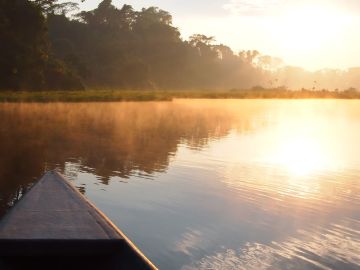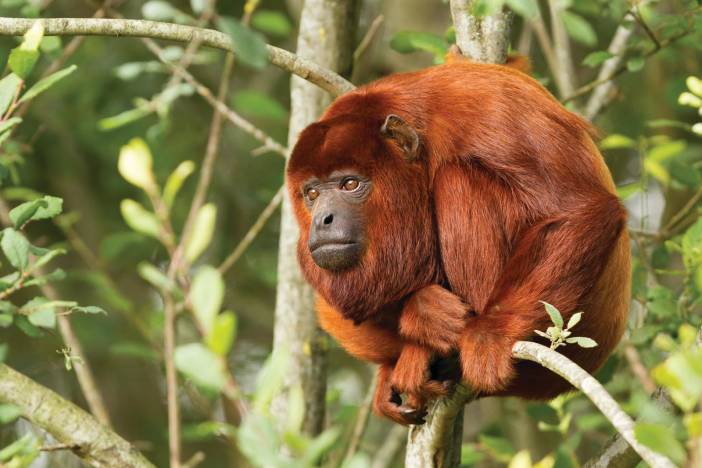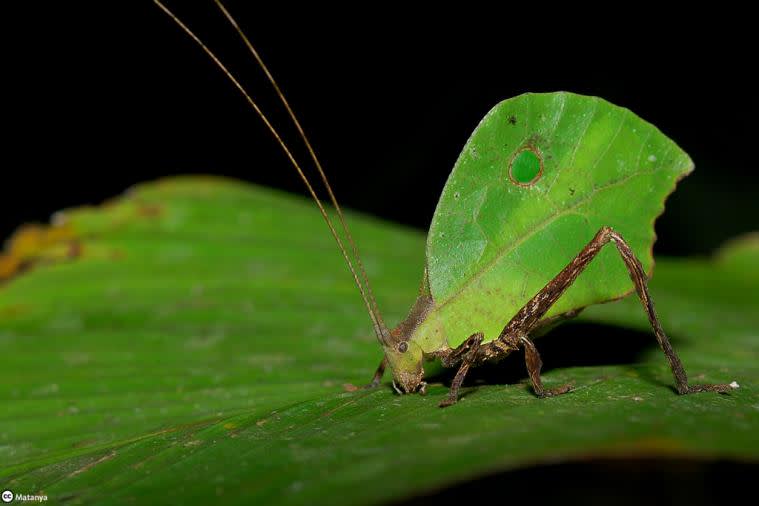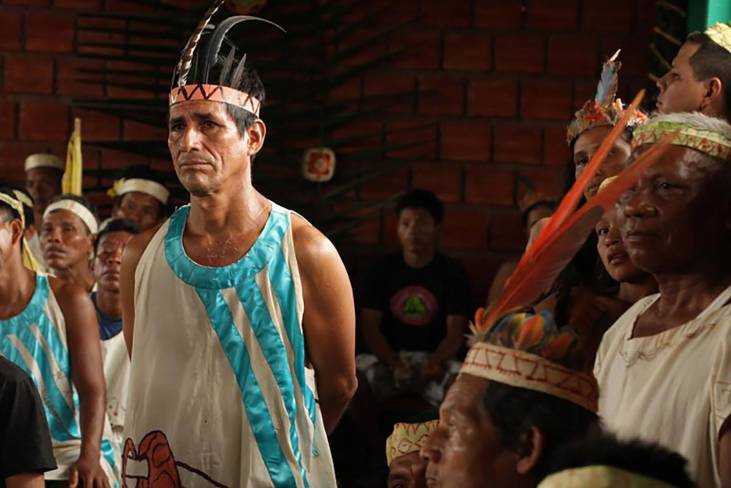
Amazon Rainforest Guide – 25 Fascinating Facts
The Amazon is a haven of superlatives. Its rainforest is the world’s biggest, its river is the world’s longest (or second longest, depending on how you measure it), and its flora and fauna rank among the world’s the most biodiverse.
In truth, virtually everything about the Amazon seems so larger-than-life, it can be difficult to decide what you want to focus on. The river itself is so vast that, at times, you can’t even see the other side. Due to regular rains, the forest is a dazzling shade of green, its vividness matched only the brilliant blue of the sky.
And then there’s the wildlife: From red howler monkeys and green iguanas to blue tree frogs, pink-toed tarantulas, and birds and butterflies in every color of the rainbow, the animals of the Amazon cover the whole spectrum.
We’ve been waxing rhapsodic about the 10 days we spent in the Peruvian Amazon for years now. But really, words don’t quite do it justice. So instead, here are 25 fascinating Amazon rainforest facts that will help explain how truly unique this classic ecotourism hotspot is.

Facts About the Amazon River
• In March of 1500, Vicente Yáñez Pinzón of Spain became the first documented European to sail up the Amazon River. But fellow Spanish explorer Francisco de Orellana was the first European to travel the entire length of the Amazon River, making the epic journey in 1541-42. He named it after the warrior women from Greek mythology because his expedition was attacked by a group of female warriors on the river.
• Due to differences of opinion on where the Amazon originates, the total length of the river is a matter of some dispute. According to the U.S Geological Survey, the total length of the Amazon River is 4,000 miles (or 6,437 kilometers), which would make it the second longest river in the world after the Nile River in Egypt (at 4,132 miles/6,650 kilometers). Other surveys put its length at 4,345 miles, which would make it the world’s longest river.
• The Amazon contains about 20% of the world’s total volume of river water. There are approximately 15,000 tributaries flowing into the river, including sources originating in Bolivia, Brazil, Colombia, Ecuador, French Guyana, Guyana, Peru, Suriname and Venezuela. The most distant source is Nevado Mismi, an 18,358-foot volcanic mountain located in the Peruvian Andes near Arequipa. Melting snow from there feeds into the Ucayali-Apurímac river system, the Amazon’s primary source.
• The Amazon receives an average of 9 feet (2.75 meters) of precipitation every year. During the wet season, which lasts from mid-December to mid-May, the river’s level rises to around 30 to 45 feet (9 to 14 meters) on average. The volume of water it releases into the Atlantic Ocean averages approximately 7,400,000 cubic feet per second, but in the rainy season it can swell up to 11,000,000 cubic feet per second.
• The Amazon River’s width varies between 1 and 6.2 miles during the dry season, but during the rainy season it expands to more than 30 miles wide in certain parts. By the time it reaches the Atlantic Ocean, the river’s width has grown to more than 150 miles.
Facts About the Amazon Basin
• The Amazon Basin, which includes all areas drained by the Amazon River and its thousands of tributaries, covers approximately 2,896,000 square miles. It encompasses around 40% of the South American continent, including parts of eight countries – Bolivia, Brazil, Colombia, Ecuador, Guyana, Peru, Suriname and Venezuela.
• The Amazon rainforest (also known as Amazonia) ranks #1 among the biggest forests in the world, covering around 2.1 million square miles. This includes approximately 60% of Peru, which is the largest extension in any country after Brazil.
• The Amazon rainforest is home to a whopping 10% of all known species in the world, including around 180 species of reptiles, 262 amphibian species, 293 types of mammals, 697 species of fish, 806 bird species, and 2,500 butterflies. This is largely due to the dense plant growth, which provides shelter for an incredible array of animals.
• There are over 40,000 different plant species found in the Amazon rainforest basin, including hundreds of types of ferns and thousands of different species of flowering plants. Very little sunlight reaches the floor of the forest due to the dense canopy. So the Amazon is a haven for shade-tolerant plants, especially orchids, bromeliads and other epiphytes that grow on trees and have aerial roots. Noteworthy Amazonian trees include the Assai palm, Brazil nut and rubber tree.
• The entire Amazon region generally remains hot and humid year-round. The average daily high temperature during the dry season (June through October) is around 100º Fahrenheit, with an occasional tropical shower to help cool things down a bit. Average high temperatures are about 12º cooler during the wet season (November through May), when over 60% of the region’s rainfall occurs. But the air still feels extremely muggy thanks to the increased level of humidity in the forest.

Animals of the Amazon
• Peru is home to the third largest number of mammals in the world, thanks in large part to the remarkably rich biodiversity of the Peruvian Amazon region. The fertile rainforest is home to approximately 300 different mammal species, including several species of big cats (pumas, jaguars, ocelots, etc.), several types of poison dart frogs, the rare Amazon River dolphin, giant river otters and armadillos, and weird animals such as the Baird’s tapir and capybara (the world’s largest rodent).
• With its pale pink body, elongated neck, a long snout reminiscent that looks a bit like a beak, a rounded head, and a smaller dorsal fin, the Amazon River dolphin is noticeably different from its ocean-faring cousin. These dolphins have traditionally been spared from tribal hunting because they were believed to be magical creatures. They’re seen frequently during excursions on Amazon River cruises, but sightings are often fleeting, which only adds to their mystical quality. Like many other aquatic animals in the region, the Amazon River dolphin is threatened by pollution and various development projects that restrict the river’s natural flow.
• The Amazon rainforest is one of the jaguar’s last remaining strongholds. Jaguar numbers are decreasing fast because of illegal hunting and loss of habitat due to deforestation. It’s estimated that only around 6000 individuals survive in the Amazon today, and the elusive animals (which tend to be more active at night) are very rarely seen by tourists. These big cats are excellent at climbing, swimming, and hunting, with the Baird’s tapir high on their list of favorite prey. The best sightings can be found in Brazil.
• Piranha have gotten a bad rap, thanks in large part to their portrayal in cheesy B-movies and unfounded folklore. Found throughout the Peruvian Amazon, these are beautiful fish with red-orange bellies who average anywhere from 5.5 to 10.25 inches long. Their reputation as ferocious predators is mostly hyperbole: Scientific research has found that they’re really timid opportunists who school together mostly for protection. But they are omnivores, and piranha will resort to cannibalism if the opportunity arises.
• There are approximately 150 different species of monkeys found in the Amazon rainforest. There are common species, including 15 types of tamarin monkeys, nine types of howler monkeys, four types of woolly monkeys, spider monkeys, capuchins, squirrel monkeys, and titi monkeys. There are unusual species such as the bald uakari, the shaggy-furred monk saki, and the nocturnal night monkey (a.k.a. owl monkey). But our favorite is the pygmy marmoset, one of the world’s tiniest primate species (and the smallest one found in the Amazon), which weighs just over 3.5 ounces measures between 4.5 and 6 inches tall.
Amphibians, Birds & Insects of the Amazon
• The Amazon is home to some 1,500 species of amphibians, the majority of which are frogs, toads, and tree frogs. In some areas, you can find up to 80 species of frogs in a small section of the rainforest. The most vivid of these species are the poison dart frogs, which are typically seen on the rainforest floor and active during daylight hours. Ranging in colors from bright red and orange to dazzling blues and greens, these frogs are notoriously toxic. Some indigenous Amazon hunters coated the tips of their darts in the poison from the frog’s skin in order to kill their prey.
• There are around 30 million species found in the Amazon River basin, with thousands of new species being discovered each year. An estimated 2.5 million of these are insects. Just one acre of the Amazon rainforest is estimated to contain as many as 70,000 species of insects, and scientists once found 700 different species of beetle on a single tree! Some of the more intriguing creepy-crawlies in the Amazon include the assassin bug, fishing spider, jewel caterpillar, jumping stick, leaf-mimic katydidand pink toe tarantula.
• Peru boasts more types of birds than any other country in the world, with over 1,800 recorded species (of which 139 are endemic). The Peruvian Amazon is a particularly huge hotspot for birdwatching enthusiasts, with some 575 avian species identified within just one 5,500-hectare section of the rainforest. By comparison, there are only 700 species of birds found in the entire continent of North America!
• One of the Amazon’s most unusual birds is the hoatzin, which is also known as the canje pheasant or the “punk-rock bird,” due to its mohawk-like crest. This colorful pheasant-sized bird, whose chicks possess claws on two of their wing digits, is occasionally humorously referred to as the stinkbird because of its pungent, manure-like odor (which is caused by its unique digestive system). The noises they make are just as weird, including a freaky variety of groans, croaks, hisses, and grunts.
• Unfortunately, deforestation in the Amazon (particularly the Brazilian section) has led conservation organizations such as the IUCN and BirdLife International to classify more than 150 bird species as a high risk for future extinction. Of these, over 40 species are currently classified as endangered. Some of the more critically endangered Amazonian birds include the banded cotinga, hyacinth macaw, purple-winged ground dove, and the red-browed Amazon.

Indigenous People of the Amazon
• According to Survival International, there are approximately 240 indigenous tribes in Brazil today (around 90,000 people in total), living in 690 different government-recognized territories. The vast majority of this reserved land (over 98%) lies within the Amazon basin. Brazil is also home to more uncontacted indigenous tribes than any other country in the world, with an estimated 80 of them living in remote corners of the Brazilian Amazon.
• The ribereños of the Peruvian Amazon are an ethnically diverse people made up of the descendants of Europeans, detribalized natives, and their mixed-race (or mestizo) offspring. Living in villages along the banks of the river, ribereños communities are often focused on farming, but fishing, hunting, extraction of forest products, and waged labor are also common ways of making a living. Most villages are home to exceptional craftsmen, and sometimes you even meet families selling goods from canoes along the river.
• Like many indigenous Amazonian tribes, the Maijuna people of northeastern Peru are often described by cultural anthropologists as “vulnerable” and “marginalized.” They descend from the Western Tucanoans, who inhabited the region for hundreds (perhaps thousands) of years before colonialism gradually decimated the population. Today there are around 500 Maijuna living in four communities in the Maijuna-Kichwa Regional Conservation Area, which was created in 2012.
• Most indigenous people of the Amazon will go to a traditional shaman (which are known locally as curanderos) for healing before seeking help from Western medicine. Shamanism is an ancient practice that combines spirituality and natural science, and its traditions have been passed down from generation to generation for centuries. The Shamanic tradition is currently in grave danger of dying out, as it is hard to find students willing to undergo the strict regimen required to study shamanic healing practices.
• For indigenous Amazonians, almost every plant in the rainforest serves a medicinal purpose (many of which have been co-opted by Western pharmaceutical companies to create familiar drugs). Some of the more commonly used plants include boldo, which is used as a diuretic, laxative and liver tonic; cinchona, the source of natural quinine, which cures malaria and is used to treat headaches, leg cramps and colds; and yerba mate, which is used to treat hay fever and asthma, improve digestion, and combat fatigue. Cat’s claw is currently being tested by scientists as a possible remedy for cancer.

